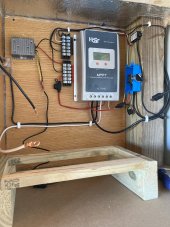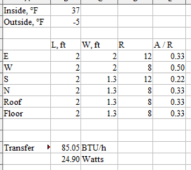I'm in south central Kansas. Abnormally cold would be lows of -5 and highs in the teens. It got that cold last week and the news said it was the coldest its been in a couple years. It was a total of 5 days where the high temp didn't exceed freezing. So I'm wanting to plan for that temp range.
With the first 3 cameras pluged in the NVR pulls around 17 watts. The NVR will be running 24/7. The camera's are powered over ethernet from the NVR so they contribute to that power draw, but their heat doesn't help keep the battery warm. Lets assume the NVR is 10 watts or more (just the hdd in it should be around 5 watts). Later on I'll be adding a raspberry pi, cell phone (for internet access), wifi router. That will probably double the full time wattage, but I haven't decided yet how much of that will be inside the insulated box.
The NVR will run 24/7, so its a full time heater. I'm wondering if this will be enough to keep the battery above freezing. When you guys heat your batteries, I think you're putting the heating pad directly on the battery, so the core battery temp will be warmer than the air temp. The heating from the NVR is indirect, so the battery temp will be the same as the air temp. I have the NVR immediately under the Without an actual heating pad I'm expecting to need a little more heating wattage, and be more vulnerable to air leaks in my box.
The insulated box is inside a post-frame style steel building (deer hunting blind). Inside the building is a little drafty and not insulated, so the air temp inside the building will closely track the outside air temp. But insude the building the box is well protected from the wind. Insulation is 1.5 inches of fiberglass on two sides. 3 inches of foam on the top and the other two sides, and 2 inches of foam on the bottom. The "door" of the box is 3" thick foam that I'll bungie cord in place, with soft/squishy foam to seal it. The box should not be very drafty since I caulked the inside of it to seal up cracks.
I was planning on buying the Wieze battery with low temp protection, but the price shot up $60 in the two weeks before I got around to ordering. If it was always that price I probably would have bought it, but that jump annoyed me so I bought the LiTime (AmpereTime) without thermal protection.
Once I get the Raspberry pi and internet connection I'll have the battery temp logged to an InfluxDB cloud account and can have it page me if the temp gets too cold. But I doubt I'll have that set up before the temps warm up in early spring. Until then, do you think this will stay warm enough?
(photos are before adding the last layer of foam)
With the first 3 cameras pluged in the NVR pulls around 17 watts. The NVR will be running 24/7. The camera's are powered over ethernet from the NVR so they contribute to that power draw, but their heat doesn't help keep the battery warm. Lets assume the NVR is 10 watts or more (just the hdd in it should be around 5 watts). Later on I'll be adding a raspberry pi, cell phone (for internet access), wifi router. That will probably double the full time wattage, but I haven't decided yet how much of that will be inside the insulated box.
The NVR will run 24/7, so its a full time heater. I'm wondering if this will be enough to keep the battery above freezing. When you guys heat your batteries, I think you're putting the heating pad directly on the battery, so the core battery temp will be warmer than the air temp. The heating from the NVR is indirect, so the battery temp will be the same as the air temp. I have the NVR immediately under the Without an actual heating pad I'm expecting to need a little more heating wattage, and be more vulnerable to air leaks in my box.
The insulated box is inside a post-frame style steel building (deer hunting blind). Inside the building is a little drafty and not insulated, so the air temp inside the building will closely track the outside air temp. But insude the building the box is well protected from the wind. Insulation is 1.5 inches of fiberglass on two sides. 3 inches of foam on the top and the other two sides, and 2 inches of foam on the bottom. The "door" of the box is 3" thick foam that I'll bungie cord in place, with soft/squishy foam to seal it. The box should not be very drafty since I caulked the inside of it to seal up cracks.
I was planning on buying the Wieze battery with low temp protection, but the price shot up $60 in the two weeks before I got around to ordering. If it was always that price I probably would have bought it, but that jump annoyed me so I bought the LiTime (AmpereTime) without thermal protection.
Once I get the Raspberry pi and internet connection I'll have the battery temp logged to an InfluxDB cloud account and can have it page me if the temp gets too cold. But I doubt I'll have that set up before the temps warm up in early spring. Until then, do you think this will stay warm enough?
(photos are before adding the last layer of foam)






